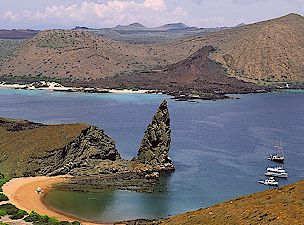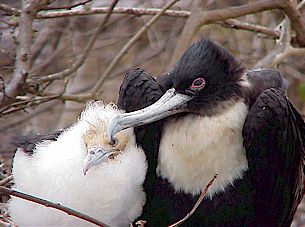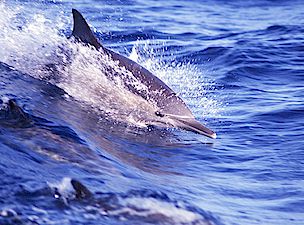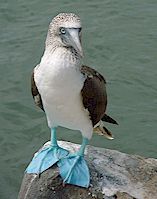Travel E-Log #8: Isabela Island
Dear students,
Hola, como estan? Hello, how are you? Saludos de la Isla Isabela. Greetings from Isabela Island.
Today, Lilia and I traveled from Santa Cruz Island to Isabela in a twenty-foot, ten-passenger, fiberglass motorboat. Our first two boat rides between islands were on a giant warship and a medium-sized passenger boat, so this trip was quite an adventure. The boat rode up and down the waves, instead of breaking through them, so the ride wasn't as rocky as the others -- just bumpier! Sometimes, only the back of the boat would be touching the water as we passed over the top of a wave, then.... Boom! The front of the boat would go crashing down on the water. But, the driver was very skilled at his craft -- in fact at one point my hat flew off and he swung the boat around to retrieve it before it sank into the ocean -- and we found the journey much less nauseating than the previous two. So now we are two for two in recovering things of ours that have fallen into the sea during our travels and six for six (three each) in long boat rides without throwing up. That's a pretty good record. Let's see if we can maintain it the rest of the project!
After
we got used to the crashing and splashing of the boat, we actually enjoyed the
ride, watching occasional petrels, shearwaters and gannets  patrolling
the waves and playing a 'What shape is it?' game with the passing small islands
and giant rocks sticking up out of the ocean. We passed Isla Santa Fe; Roca
Sin Nombre (No-Named Rock), known locally as Pan con Azucar (Bread with Sugar);
Isla Pinzon (Finch Island, a.k.a. Duncan Island); Los Cuatro Hermanos (The Four
Brothers), which are four large rocks close to each other; Isla Tortuga (Turtle
Island); and a pointed rock called La Veuda (The Widow). We also saw Floreana
Island off in the distance the whole trip; and, as we got closer to our destination,
we could see a section of Isabela Island known as La Ballena (The Whale), because,
from a distance, it looks like a giant whale.
patrolling
the waves and playing a 'What shape is it?' game with the passing small islands
and giant rocks sticking up out of the ocean. We passed Isla Santa Fe; Roca
Sin Nombre (No-Named Rock), known locally as Pan con Azucar (Bread with Sugar);
Isla Pinzon (Finch Island, a.k.a. Duncan Island); Los Cuatro Hermanos (The Four
Brothers), which are four large rocks close to each other; Isla Tortuga (Turtle
Island); and a pointed rock called La Veuda (The Widow). We also saw Floreana
Island off in the distance the whole trip; and, as we got closer to our destination,
we could see a section of Isabela Island known as La Ballena (The Whale), because,
from a distance, it looks like a giant whale.
It was fun debating what the islands looked like. Though the actual shapes never really changed, it seemed as if they did depending on our perspective. From one side of Tortuga Island, for example, you could easily see how it got its name, but from the other side, it looked like a giant fish hook. La Veuda, to me, looked like a giant pirate ship from the distance, but when we got closer, Lilia thought it looked like a sitting lion. The Four Brothers morphed into several different shapes - from bread loafs to turtles and from sleeping sea lions to whales - as we looked at them from changing points of view.
=================================
The Issue of Introduced Animals
Even though we didn't spill our cookies, it felt good to reach the town of Puerto Villamil on Isabela Island. It's a small town of around 1000 (human) inhabitants with sand streets; lots of palm trees; a saltwater lagoon with flamingos, ducks and black-necked stilts; a cozy mangrove cove for swimming; and a beautiful beach. We were immediately enchanted. But another thing that caught our eye right away was the large number of dogs wandering through the streets.
 Now,
normally, you would probably consider dogs, cats, goats, pigs, donkeys and the
like to be some of the tamest and friendliest animals on the planet, right?
But, in the Galapagos, that's NOT necessarily the case. While sometimes these
introduced animals are tame in the Galapagos, as in the case of the dogs we
saw in Puerto Villamil and goats, cows and horses that are raised on farms in
the Galapagos highlands, on the whole, animals that are usually domesticated
by people are, by far, the most destructive animals on the islands. Why is that?
Now,
normally, you would probably consider dogs, cats, goats, pigs, donkeys and the
like to be some of the tamest and friendliest animals on the planet, right?
But, in the Galapagos, that's NOT necessarily the case. While sometimes these
introduced animals are tame in the Galapagos, as in the case of the dogs we
saw in Puerto Villamil and goats, cows and horses that are raised on farms in
the Galapagos highlands, on the whole, animals that are usually domesticated
by people are, by far, the most destructive animals on the islands. Why is that?
Well, introduced animals never lived in the Galapagos until humans brought them there. Over time, many of these animals, once tame, became wild. Once wild, some of them, like dogs and cats, started to prey on the endemic animals of the Galapagos and others, like goats and horses, began to compete with endemic animals for food. Packs of wild dogs, for example, have been known to raid marine iguana colonies, killing and eating as many as 500 in one colony in one year on one island. Rats and pigs raid giant Galapagos tortoise nests, devouring thousands of turtle eggs and threatening the populations of certain subspecies. Goats consume huge areas of vegetation that would normally be eaten by endemic species, like tortoises, and cause severe soil erosion.
To
combat the threat of introduced species, The Charles Darwin Scientific Station
and the Galapagos National Park Service have been working together to control and eradicate introduced animals. But it's not easy. Hunting
down wild populations of introduced animals is very challenging because of the
Galapagos's lava terrain thick thorny vegetation. Setting traps or using poison
is tricky because native species might also get caught or poisoned. Other methods,
like fencing, scientific research and 'biological' control, are expensive, slow
and sometimes relatively ineffective. While scientists and park rangers have
had some success (wild goats, for example, have been eradicated on five small
islands and wild dog populations have been reduced and controlled on some major
islands), the threat of introduced species continues to be a major issue on
the islands.
together to control and eradicate introduced animals. But it's not easy. Hunting
down wild populations of introduced animals is very challenging because of the
Galapagos's lava terrain thick thorny vegetation. Setting traps or using poison
is tricky because native species might also get caught or poisoned. Other methods,
like fencing, scientific research and 'biological' control, are expensive, slow
and sometimes relatively ineffective. While scientists and park rangers have
had some success (wild goats, for example, have been eradicated on five small
islands and wild dog populations have been reduced and controlled on some major
islands), the threat of introduced species continues to be a major issue on
the islands.
What would you do to combat the problem if you were a scientist or park official on the Galapagos Islands? Your teacher has the addresses of some Web sites that explore the topic in more detail - and information on how you can become 'Friends of the Galapagos.'
================================
Guess-Who!
Speaking of threatened animals, here's another animal-math poem for you. Note that the temperatures mentioned in the poem are in Celsius. Can you convert them into Fahrenheit? Guess who!
Oh, I'm bobbing
Bobbing for a living
Just bobbing
Bobbing for a living
Just a-bobbing
Bobbing for a living in the sea
One - two - three
In the sea
One - two - three
In the oh - say - ah - no
The wide, wide, big old sea.
Three
thousand of me
Bobbing in the sea
Bouncing in the blue
Happy and free
Twenty-two, twenty-three Twenty-four degrees
Uh-oh, too hot for me!
Two thousand of me
Bobbing in the sea.
Oh, I'm bobbing
Bobbing for a living
Just bobbing
Bobbing for a living
Just a-bobbing
Bobbing for a living in the sea
One - two - three
In the sea
One - two - three
In the oh - say - ah - no
The wide, wide, big old sea.
Two thousand of me
Bobbing in the sea
Bouncing in the blue
Happy and free
Twenty-two, twenty-three Twenty-four degrees
Oh-oh, too hot for me!
One thousand of me
Bobbing in the sea.
Oh,
I'm bobbing
Bobbing for a living
Just bobbing
Bobbing for a living
Just a-bobbing
Bobbing for a living in the sea
One - two - three
In the sea
One - two - three
In the oh - say - ah - no
The wide, wide, big old sea.
One
thousand of me
Bobbing in the sea
Bouncing in the blue
Happy and free
Twenty-two, twenty-three Twenty-four degrees
Oh-oh, too hot for me!
That's the end, you see
What a tragedy
I'm just a memory
And there will never be
More bobbing in the sea for me.
So please, please
Think about me
When you go to litter
When you buy gasoline
When you burn up things unnecessarily
We've got to find a way to keep ocean cool
So I can keep bobbing in the sea.
In the sea
In the oceano
The wide, wide, big old sea.
(Thank you, kindly!)
===================================
Answers for the Last Report
The
animal represented in the last report's guess-who poem was the blue-footed
booby.  Did
you also figure out the references to other birds in the poem? The splash in
the pan trick refers to one of the brown pelican's fishing techniques, and the
thieving pirate ship to one of the frigate bird's preferred methods, since it
often steals fish, midair, from smaller birds (like boobies).
Did
you also figure out the references to other birds in the poem? The splash in
the pan trick refers to one of the brown pelican's fishing techniques, and the
thieving pirate ship to one of the frigate bird's preferred methods, since it
often steals fish, midair, from smaller birds (like boobies).
Did you get out your compass and protractor to figure out the mathematical figures and angles mentioned in the poem? Three hundred and sixty degrees represents a circle, of course, and, in the poem, the circles that a blue booby makes as it flies over the bay looking for small fish. One hundred and eighty degrees represents the angle of a straight line, a ray or a plane, in the poem referring to the surface of the water and the parallel plane in which the boobies make their circles. The rest of the numbers, 90, 80, 50, 45 and 30, represent the degrees of the angles at which the booby dives after fish.
=================================
Question-and-Answer Exchange
Here are more question answers, this time provided by students from three different islands, San Cristobal, Santa Cruz and Isabela (the island is indicated in parentheses).
How often do you swim in the ocean?
Most of us swim in the ocean at least two or three
times a week, some of us almost every day. (San Cristobal)
Have you ever seen red-hot lava or exploding volcanoes?
No, though, if we go into the highlands region of our
island, we can see smoking volcanoes. (Isabela)
When
was the last time a volcano erupted in your country?
A volcano in the rain forest of Ecuador, called Reventador,
erupted about two months ago. That's in our country, but not in the Galapagos
Islands. The last time a volcano erupted on our island was in 1979 (Volcan Chico).
There were eruptions in 1991 and 1995 on our neighboring island, Fernandina.
(Isabela)
Why
don't scientists put a different species of tortoise on Pinta Island?
We don't really know. Maybe because they think there
still might be some Pinta tortoises still on the island. (Isabela)
===================================
Well, that's all for this report. In the next one, I'll tell you more about Isabela. Till then....
Learn lots,
Paul
================================
Teachers: The last question/answer and guess-who animal math poem sections will appear in report #9. Also, Lilia and I have created three new sections of the Galapagos Islands School Project Web site. They are lots of fun, so have a look! To visit students at the Tomas de Berlanga School, go to A School Fieldtrip of La Escuela Tomas de Berlanga. Please visit Incredible Animals of the Galapagos, featuring the guess-who animal math poems from the E-mail reports, with audio of the 'animals' reciting or rapping their poems, plus photos of the animals; and Mystery Animal Profiles, modeled after the guess-who pelican photo series from the E-mail reports and featuring six Galapagos animals.
Finally, for information about how your class can become 'Friends of the Galapagos,' visit www.galapagos.org.
Index
Page
Meet the Adventure Team
E-Log#1:
New York
E-Log#2: Quito, Ecuador
E-Log#3: San Cristobal,
Galapagos
E-Log#4: San Cristobal,
Galapagos
E-Log#5:
Santa Cruz Island
E-Log#6:
Santa Cruz
E-Log#7: Santa Cruz
E-Log#8:
Isabela Island
E-Log#9:
Isabela
© 2007 OneWorld Classrooms. Text by Paul Hurteau. Photos by Dennis Pippen, Lilia Cai and Miguel Mosquero. All rights reserved.